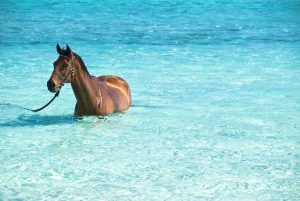
We’ve hit the hottest portion of the summer and we are witnessing our horses attempt to keep cool by sweating. The process of sweating causes a decrease in core temperature through evaporative cooling at the skin surface. As high energy molecules evaporate from the skin, releasing energy absorbed from the body, the skin and superficial vessels decrease in temperature. Cooled venous blood then returns to the body’s core and counteracts rising core temperatures. During hot weather and during exercise in hot weather, horses are able to produce an abundance of sweat to aid in the cooling process. Sweat consists mainly of water, but it also contains minerals known as electrolytes. During hot weather, sweating is a vital means of cooling horses, but the water and electrolytes in sweat must be replenished to keep the horse healthy.
Dehydration can occur when horses lose large volumes of sweat. Normally, horses will drink enough water to replenish sweat losses. However, when sweat loss occurs rapidly or when large volumes of sweat are lost the body is slow to signal it is necessary for the horse to drink. The methods to ensure your horse is drinking enough water are listed below:
- Always provide free-access to fresh clean water
- Make sure any odors are masked in water the horse is not used to drinking by adding flavors to the water.
- Offer your horse water is a quiet area where other horses can’t disrupt his ability to get enough water.
- If you horse is a poor drinker, wet down his food (both hay and grain) prior to feeding it. This will provide the horse with additional water in every mouth full of feed.
The other major component of sweat are minerals know as electrolytes. These minerals are salts which dissolve into charged ions in water. These ions are important to muscle contraction, nerve function and general health of the horse. The major electrolytes lost in sweat include sodium, chloride, potassium, calcium and magnesium. If these electrolytes are not replaced when a horse sweats the horse may develop muscle cramps, become uncoordinated and may have impaired nerve and brain function. Replacement of electrolytes may be as simple as providing the horse with access to a salt block. Unfortunately, some horses do not consume salt from a block and commercial electrolytes powders provide a quick and easy solution. Remember it is important to follow label directions on electrolyte preparations because too much electrolyte can be as devastating as too little electrolyte. It is also important to provide electrolytes in the feed and not in the water. Some horses will reject water that is supplemented with electrolytes making them not want to drink. This further increases the chances of dehydration.
Other considerations in hot weather includes fluid/weight loss. Exercise generates a great deal of heat that must either be dissipated from the body or stored. The dissipation of heat is very important, because if a large amount of heat is stored, body temperature will rise to dangerous levels. In the horse, the processes that contribute to the dissipation of heat during exercise include radiation, convection, conduction and evaporation. Of these, evaporation may be the most important; particularly when horses are exercised in warm conditions. To facilitate evaporative cooling, horses sweat. Sweating is certainly desirable as a means to maintain body temperature, but high sweating rates result in high rates of water and electrolyte loss.
Range of weight losses when horses were weighed before and after various events indicating sweat loss**
| Type of horse | Range of weight loss (kg) |
| Standard Harness Horse (before and after a 1 mile race) |
5 to 15 |
| Field Hunters (before and after 3 hours of fox hunting) |
10 to 45 |
| Thoroughbred horses in race training (before and after galloping) |
4.5 to 7 |
| Endurance horses (from the night before a race to the end of 85km) |
10 to 40 |
** These values may not apply to all horses performing these types of events
Horses consist of approximately 60% water, which works out to be around 270 kg of water for a 450 kg horse. Most of the water is contained in cells (intracellular water) but some is outside of individual cells (extracellular water). Blood plasma, which constitutes a large portion of the horse’s blood volume, is an important component of the extracellular water pool. When horses sweat, some of the water in sweat is obtained from the plasma volume. Consequently, if sweat losses are large, the plasma volume may decrease. A reduction in plasma volume (and thus total blood volume) may affect the ability of the horse to maintain adequate blood flow to muscles during work. Progressive dehydration may also result in a reduction in sweating rate and thus an increase in body temperature. This is why electrolytes are so important in the horse.
So when the hot weather is behind us can we simply forget about electrolytes? The answer is no. Electrolytes are minerals that a horse needs on a daily basis. The volume or amount of electrolytes needed in cool weather is less than needed in hot, humid weather, since the amount of sweat is less but electrolytes are still required. Maintaining a simple year-round electrolyte program will pay dividends with improved health of the horse.
